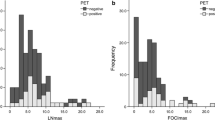Abstract
Introduction
Improvement in esophageal cancer staging is needed. Positron emission tomography (PET), computed tomography (CT), and endoscopic ultrasound (EUS) in the staging of esophageal carcinoma were compared.
Methods
PET, CT, and EUS were performed and interpreted prospectively in 75 patients with newly diagnosed esophageal cancer. Either tissue confirmation or fine needle aspiration (FNA) was used as the gold standard of disease. Sensitivity and specificity for tumor, nodal, and metastatic (TNM) disease for each test were determined. TNM categorizations from each test were used to assign patients to subgroups corresponding to the three treatment plans that patients could theoretically receive, and these were then compared.
Results
Local tumor staging (T) was done correctly by CT and PET in 42% and by EUS in 71% of patients (P value > 0.14). The sensitivity and specificity for nodal involvement (N) by modality were 84% and 67% for CT, 86% and 67% for EUS, and 82% and 60% for PET (P value > 0.38). The sensitivity and specificity for distant metastasis were 81% and 82% for CT, 73% and 86% for EUS, and 81% and 91% for PET (P value > 0.25). Treatment assignment was done correctly by CT in 65%, by EUS in 75%, and by PET in 70% of patients (P value > 0.34).
Conclusions
EUS had superior T staging ability over PET and CT in our study group. The tests showed similar performance in nodal staging and there was a trend toward improved distant disease staging with CT or PET over EUS. Assignment to treatment groups in relation to TNM staging tended to be better by EUS. Each test contributed unique patient staging information on an individual basis.



Similar content being viewed by others
References
Goldberg M, Farma J, Lampert C et al. (2003) Survival following intensive preoperative combined modality therapy with paclitaxel, cisplatin, 5-fluorouracil, and radiation in resectable esophageal carcinoma: A phase I report. J Thorac Cardiovasc Surg 126(4):1168–1173
Saltzman JR (2003) Section III: Endoscopic and other staging techniques. Semin Thorac Cardiovasc Surg 15(2):180–186
Lerut T, Coosemans W, Decker G et al. (2004) Extended surgery for cancer of the esophagus and gastroesophageal junction. J Surg Res 117(1):58–63
Rice TW (2000) Clinical staging of esophageal carcinoma. CT, EUS, and PET. Chest Surg Clin North Am 10(3):471–85
van Westreenen HL, Westerterp M, Bossuyt PM et al. (2004) Systematic review of the staging performance of 18F-fluorodeoxyglucose positron emission tomography in esophageal cancer. J Clin Oncol 22(18):3805–3812
Wallace MB, Nietert PJ, Earle C et al. (2002) An analysis of multiple staging management strategies for carcinoma of the esophagus: Computed tomography, endoscopic ultrasound, positron emission tomography, and thoracoscopy/laparoscopy. Ann Thorac Surg 74(4):1026–1032
Rosh T, (1994) Endoscopic ultrasonography. Endoscopy 26:148–168
Wiersema MJ, Giovannini VPM, Chang KJ, Wiersema LM (1997) Endosonography-guided fine-needle aspiration biopsy: Diagnostic accuracy and complication assessment. Gastroenterology 112:1087–1095
Lerut T, Flamen P, Ectors N et al. (2000) Histopathologic validation of lymph node staging with FDG-PET scan in cancer of the esophagus and gastroesophageal junction: A prospective study based on primary surgery with extensive lymphadenectomy. Ann Surg 232(6):743–752
Kneist W, Schreckenberger M, Bartenstein P, Grunwald F, Oberholzer K, Junginger T (2003) Positron emission tomography for staging esophageal cancer: does it lead to a different therapeutic approach? World J Surg 27(10):1105–1112
Heeren PA, Jager PL, Bongaerts F, van Dullemen H, Sluiter W, Plukker JT (2004) Detection of distant metastases in esophageal cancer with (18)F-FDG PET. J Nucl Med 45(6):980–987
Acknowledgements
We would like to thank Terry Brinkman for her administrative support of this project. This study was supported by Mayo Foundation.
Author information
Authors and Affiliations
Corresponding author
Rights and permissions
About this article
Cite this article
Lowe, V.J., Booya, F., Fletcher, J.G. et al. Comparison of Positron Emission Tomography, Computed Tomography, and Endoscopic Ultrasound in the Initial Staging of Patients with Esophageal Cancer. Mol Imaging Biol 7, 422–430 (2005). https://doi.org/10.1007/s11307-005-0017-0
Published:
Issue Date:
DOI: https://doi.org/10.1007/s11307-005-0017-0




